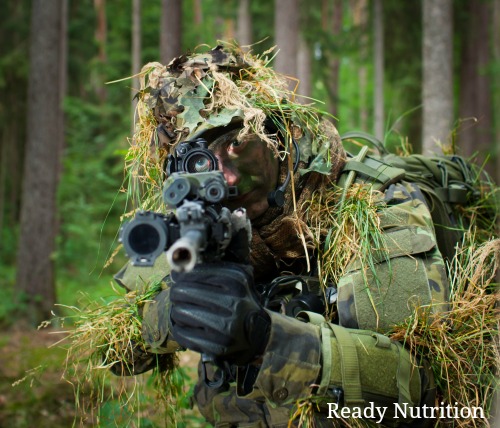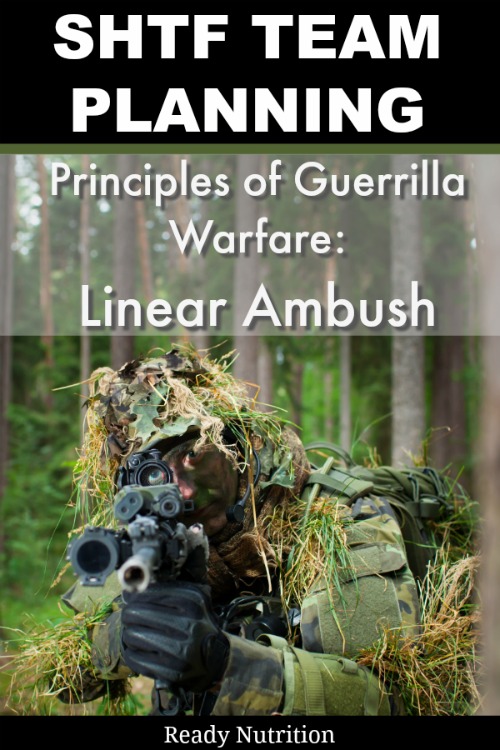
The way the kids are prepositioned on the heights, they are spread in a line (a linear formation). As it is an armored column, when the first explosion goes off, the kids (Leah Thompson) opens up with the machine gun…the highest casualty-producing weapon of the unit. She “closes the front door,” that is, takes down the lead vehicle and halts the progress of the column. Then the “back door” is closed as the (pseudo)APC/BRDM is engaged, bottling up the main element between the two KO’d vehicles.
Then the group opens up on everything in the middle…this is the “Kill Zone” of the ambush. The Soviets try to take the lower ground, but the kids have set claymores on the slopes and in the trees, and give them the “dam-dam,” as they mop up on the kill zone.
They don’t do it perfectly, but the film is a very realistic training tool. Nothing ever goes perfectly, as von Clausewitz noted: “No battle plan ever survives the first five minutes of contact intact.”
Two principles were covered with the deployment of the claymores on the slopes of the ambush site. First, always recon the objective precisely. Secondly, if there’s time, physically prepare the objective, as with positioning the mines.
Clear and Simple Steps to a Linear Ambush
The linear ambush is simple, with simple elements, and we’ll list the principles here:
- Whatever you’re ambushing, be it vehicles or dismounted men, turn it into a formation you can work with…this is called shaping your target. This is going to be dependent on your weapons and capabilities. Shaping can be done by the following method: 1) know the planned route of the enemy, 2) know his strength, composition, and numbers, 3) in accordance with the terrain, find an area he will travel over that will lend to your operation…a narrow defile (as with a canyon or valley), a narrow road on the side of a hill or mountain…. or passing through a “choke” point, such as a tunnel. Shape him this way. If you can keep him in a large, clustered group? Frogs in a puddle. Stretch him out far and thin? If you can close the front and back doors and put fire along his length on a line, then go for it.
- Restrict his mobility. Use water features, cliffs, or thick, uneven terrain to trap him. If he’s immobilized, he’s staked out and ready to destroy.
- Ensure you (as the ambushing element) have at least 10 meters in between each individual position with adequate concealment and good cover.
- Be advised: the textbook response for them (the enemy) is to turn the entire element in your direction, face you, and charge at you. Give them something to think about: punji stakes, pits, deadfalls, and (if you can do it) mines and explosive charges. Please note: when you must assault the objective, and traverse the ambush site…ensure you know where your own traps are…mines work both ways, you know. While they charge and find your “surprises” put them under fire. Make them pay for every inch of advance. This is why the ambush of the kids was so effective in the film: they had the heights and struck effectively, preventing a charge to counter them.
- Close that front and back door, and each individual in your ambushing element (lead man, trail man) must remain in place…with primary fires kept right upon those lead and trail vehicles/initial engagement points, respectively. They have a critical secondary function: they prevent anyone inside from escaping “out of the doors,” and also keep any relieving forces from entering the kill zone or flanking the rest of your teammates on the line. They must be vigilant, diligent, and ready to rock and roll to protect the rest of your group
- Prisoners: it’s up to you. Geneva Convention places you in a different status if you don’t treat prisoners accordingly. Conversely, the invading force will label you as terrorists and criminals and will execute you. I will mention this: when conducting guerrilla warfare against a conventional force, you will need to interrogate at least one prisoner if possible. The laws of land warfare are as applicable to a besieged populace fighting a guerrilla war as the Marquis of Queensbury rules are to you in a street fight. Use your own judgement.
- Weapons and equipment: After you’ve mopped up and secured the area, you want to cross-load the members of the assault team with as much weapons and equipment as they can carry, and move them out. Do not spend more than a few minutes on the objective. You’d be surprised how quickly a QRF (Quick Reaction Force) to relieve them can arrive by chopper (helicopters, not Harleys)
- Intel Team: should consist (initially) of everyone on the ambush. Then when the “scavenging” group is moving out with weapons, explosives, food (prioritize according to pre-determined needs and stick to them), the intel team (never less than two, and optimally with four people) can conduct searches of the bodies of killed enemy soldiers…maps, orders, paperwork, radios, and anything sensitive or useful to the overall war effort of the United States of America. IF YOU DON’T UNDERSTAND IT, THAT DOESN’T MEAN IT’S INSIGNIFICANT!
- Sweep up the objective: Clean it up. Nothing to give you or your group away. Nothing. Do not return to your base camp by the same route you arrived. Sweep tracks, bust up the direction of travel, and take your time…. not necessarily traveling as a unit. Small groups of two or three taking different routes, and maybe laying low to evade anyone on your tail.
- AAR: (After Action Review). This needs to be conducted as soon as you’re safe in your own territory. Critical function: go over anything you did. Any of you get killed? Touch on all the bases…. everything from mission prep and LD (Line of Departure) to the actions on the objective, and the withdrawal and return. Discuss everything: this is how you learn and perfect yourselves as a unit.
This is reality, and in warfare, it is life or death.
So, you home-can foods and stockpile things? Is it just for your family? If an invasion occurs, you may not be one of the ones fighting…but you may be the “hidden factor” that enables the ones who are fighting to make it. Use your skills as you can, and remember: we can all serve in some capacity. Citizen-soldiers, right? For every combat soldier, you need three in the rear and secured areas to supply that soldier. If you can’t be the ones on the front lines, you can still help them: with food, shelter, medicine…anything they need.
One way or another, keeping our freedom will mean giving of ourselves and sacrificing something toward concepts higher than ourselves.
I’m an American, and when it comes I’m going to fight…as a Junkyard Dog. They’ll know they were in a fight. Consider this “series” on Guerrilla warfare and remember: you wouldn’t be enjoying them and neither would I…but for those who lived before us…and gave all…for us to keep them. Stay in that good fight, and train for when it becomes real. “When” it becomes real, not “if.” As you train in peace, so shall you fight in war. More to follow. JJ out!
(Sign up for our FREE newsletter to get the latest prepping advice, gardening secrets, homesteading tips and more delivered straight to your inbox!
Additional Reading:
A Green Beret’s Guide to Improvised Home Defense Strategies
ManTracker: How to Be One and How to Avoid One
Improve Your Natural Night Vision
Prepper Sustainability: How to Observe and Monitor Local Game

This article was originally published at Ready Nutrition™ on May 10th, 2018







Mucho Gusto!!!!!!!!!!!! always good to learn new(old stuff) tactics!! I’ve watched that movie a dozen times and still pick out things they do to ambush/attack the enemy!
JJ,
Good article.
Also, saw the original Red Dawn (1984) on its opening day and it was an eye opener as well as emotional for many in the theater. Also agree that it has some training qualities also. The re-make of Red Dawn (2012) was enjoyable also and it also had some possible training qualities also. Such as: the checkpoint scene. Attract suspicious attention, have the target(s) follow, eliminate said target(s), strip them of resources, and exit the area within a predetermined limited amount of time.
There are probably more scenes in each movie that can enhance our training.
Do you have any more recommendations from/about other films on this subject?
Thx and keep the info flowing.
Guess anonymous posters are not welcome here